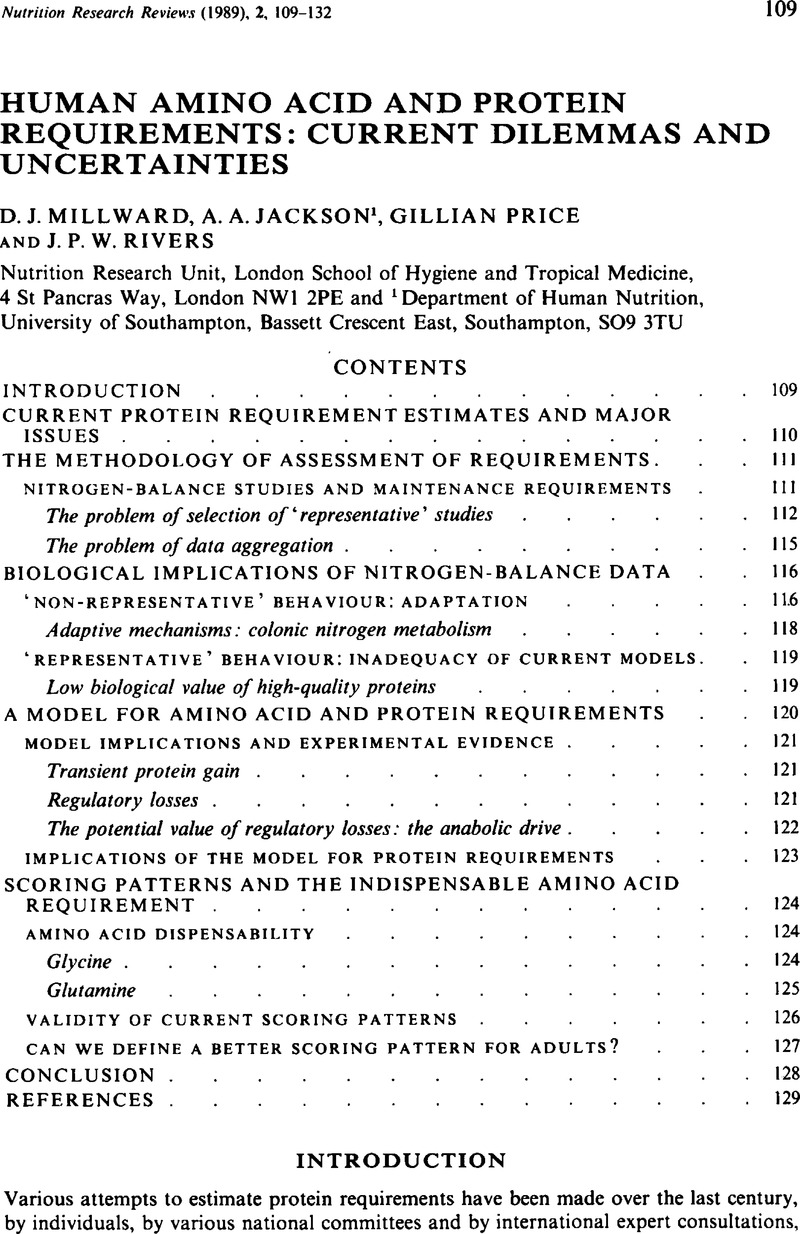Crossref Citations
This article has been cited by the following publications. This list is generated based on data provided by Crossref.
Millward, D.J.
1990.
The hormonal control of protein turnover.
Clinical Nutrition,
Vol. 9,
Issue. 3,
p.
115.
Millward, J
1990.
Amino acid requirements in adult man.
The American Journal of Clinical Nutrition,
Vol. 51,
Issue. 3,
p.
492.
Millward, D. J.
Price, G. M.
Pacy, P. J. H.
and
Halliday, D.
1990.
Maintenance protein requirements: the need for conceptual re-evaluation.
Proceedings of the Nutrition Society,
Vol. 49,
Issue. 3,
p.
473.
Reeds, Peter J.
1990.
Amino Acid Needs and Protein Scoring Patterns.
Proceedings of the Nutrition Society,
Vol. 49,
Issue. 3,
p.
489.
YOUNG, VERNON R.
YU, YONG‐MING
and
FUKAGAWA, NAOMI K.
1991.
Protein and Energy Interactions Throughout Life1.
Acta Paediatrica,
Vol. 80,
Issue. s373,
p.
5.
Millward, D.J.
Price, G.M.
Pacy, P.J.H.
Quevedo, R.M.
and
Halliday, D.
1991.
The nutritional sensitivity of the diurnal cycling of body protein enables protein deposition to be measured in subjects at nitrogen equilibrium.
Clinical Nutrition,
Vol. 10,
Issue. 5,
p.
239.
Fern, E. B.
Bielinski, R. N.
and
Schutz, Y.
1991.
Effects of exaggerated amino acid and protein supply in man.
Experientia,
Vol. 47,
Issue. 2,
p.
168.
Carpenter, KJ
1992.
Protein requirements of adults from an evolutionary perspective.
The American Journal of Clinical Nutrition,
Vol. 55,
Issue. 5,
p.
913.
Grimble, George K.
Payne-James, J. Jason
and
Silk, David B.A.
1992.
Advances in nutrition in the critically ill.
Baillière's Clinical Anaesthesiology,
Vol. 6,
Issue. 2,
p.
213.
Millward, J
1993.
Stable-isotope-tracer studies of amino acid balance and human indispensable amino acid requirements.
The American Journal of Clinical Nutrition,
Vol. 57,
Issue. 1,
p.
81.
Grimble, George K.
1993.
Essential and Conditionally-Essential Nutrients in Clinical Nutrition.
Nutrition Research Reviews,
Vol. 6,
Issue. 1,
p.
97.
Egun, Gloria N.
and
Atinmo, Tola
1993.
Protein requirement of young adult Nigerian females on habitual Nigerian diet at the usual level of energy intake.
British Journal of Nutrition,
Vol. 70,
Issue. 2,
p.
439.
Bartknecht, Wolfgang
1993.
Explosionsschutz.
p.
282.
Marchini, JS
Cortiella, J
Hiramatsu, T
Chapman, TE
and
Young, VR
1993.
Requirements for indispensable amino acids in adult humans: longer-term amino acid kinetic study with support for the adequacy of the Massachusetts Institute of Technology amino acid requirement pattern.
The American Journal of Clinical Nutrition,
Vol. 58,
Issue. 5,
p.
670.
Pirie, N. W.
1994.
Vegetables and Vegetable Products.
Vol. 16,
Issue. ,
p.
1.
Poskitt, Elizabeth M. E.
1994.
Infant Nutrition.
p.
163.
Campbell, WW
Crim, MC
Dallal, GE
Young, VR
and
Evans, WJ
1994.
Increased protein requirements in elderly people: new data and retrospective reassessments.
The American Journal of Clinical Nutrition,
Vol. 60,
Issue. 4,
p.
501.
1994.
Abstracts of Communications.
Proceedings of the Nutrition Society,
Vol. 53,
Issue. 3,
p.
158A.
Reeds, PJ
and
Hutchens, TW
1994.
Protein Requirements: From Nitrogen Balance to Functional Impact.
The Journal of Nutrition,
Vol. 124,
Issue. ,
p.
1754S.
Millward, Joe
1994.
Can We Define Indispensable Amino Acid Requirements and Assess Protein Quality in Adults?.
The Journal of Nutrition,
Vol. 124,
Issue. ,
p.
1509S.





